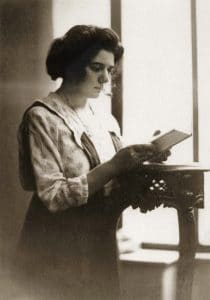A childhood in which nothing happens and which is as desolate as it is lonely. You would think that would hardly provide material for a book, but Dolores Prato (1892-1983) proved otherwise. Her autobiographical novel There in the square is no one, roughly 800 pages thick, was published in a very much abridged version more than 40 years ago. Prato, then already very elderly, was not happy with that editorial intervention. But it took until well after her death for the full version to see the light of day, now excellently translated into Dutch by Jan van der Haar.
Uncle
Prato grew up with her uncle and aunt - brother and sister - in the Italian village of Treja (Treia) in the Marches. Her mother, a licentious woman whose 'euphilia pamphlet' was gossiped about heavily in the village, brought her illegitimate daughter into the home of this aunt and uncle not long after her birth. The jolly priest ('Nonkeltje') and his dear sister with a bosom like an 'altar with no cross and no candlesticks', mean no harm, but are totally unsuitable as parents. 'I lived cloistered with two elderly people who could not adapt to my childhood.'

Little Dolores is never hugged or kissed; the only time her aunt takes her on her lap is when she has shattered her nose in a fall. Her life is lonely and barren, and there are hardly any friends during her primary school days either. She cherishes fond memories only of Ernesta, the 'wrong' friend of another uncle who laughs with her and plays a kind of 'hop horse hop': 'the only loose fun of my childhood'. Significantly, then, it is how Dolores completes the nursery rhyme they sing: 'Stomach quince, marzipan, there in the square... is no one.' Ouch.
Pointillist painting
Partly because of that solitude, she learns to observe life, others, so well. Because watching and listening is something Dolores Prato can do all too well. 'I know I never had a memory,' she writes, 'what a memory looks like is a collection of scars, or an album of engravings.' But this meticulous autobiographical account is akin to a pointillist painting: all the dots, all the little details, add up to a painting of several years of a childhood.
Like a hummingbird butterfly, she flutters from one scene to another, from one subject to another. From New Year's Eve and the annual fairs, she takes the reader to Carnival and Easter, from one season to the next, past regional dishes and appellations, customs and attitudes, while in the meantime a motley procession of fellow villagers and family members pass by - we get to know the village and Dolores down to the smallest details.
The apparent ease with which Prato does so, the metaphors she uses in the process and the often shrouded, witty (and sometimes touching) descriptions that also imbue her novel with a certain lightness, betray a great literary talent. In return, Prato demands something in return from her reader; amid today's plot-driven literary landscape, an eight-hundred-page book of meandering prose requires surrender and concentration. But those who find themselves swept away by There in the square is no one be carried away, will be rewarded with an extraordinary reading experience.
Dolores Prato, There in the square is no one. Translated by Jan van der Haar.
De Arbeiderspers, 829 p., €45.00
